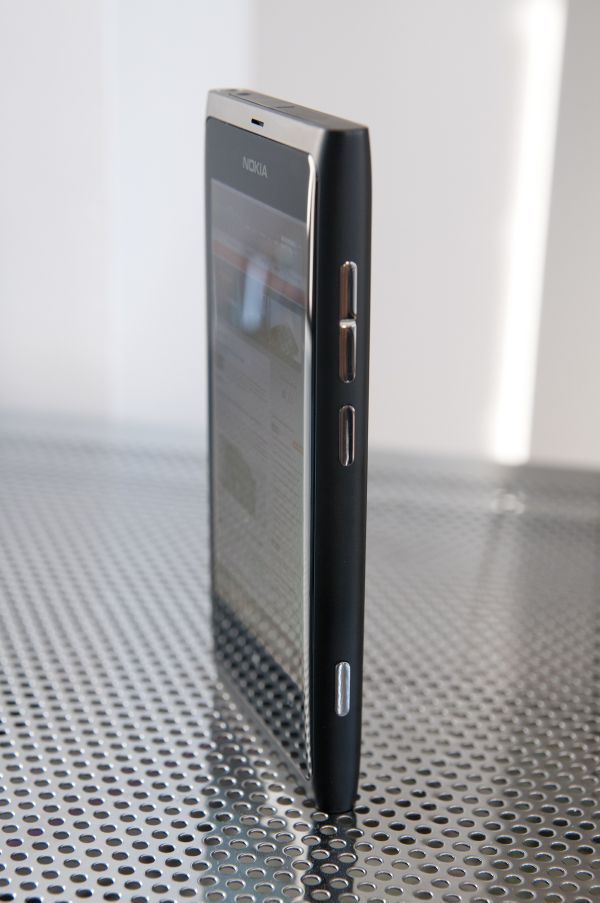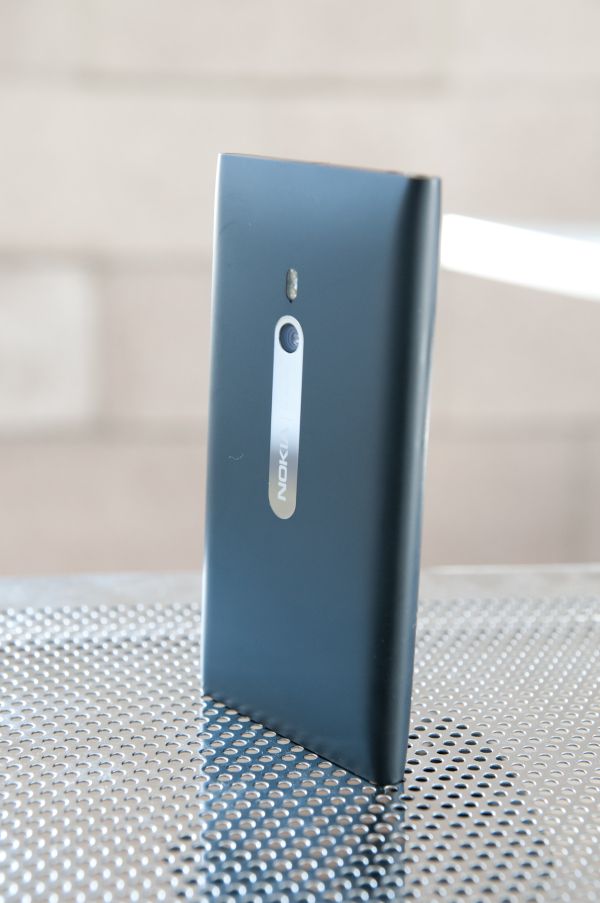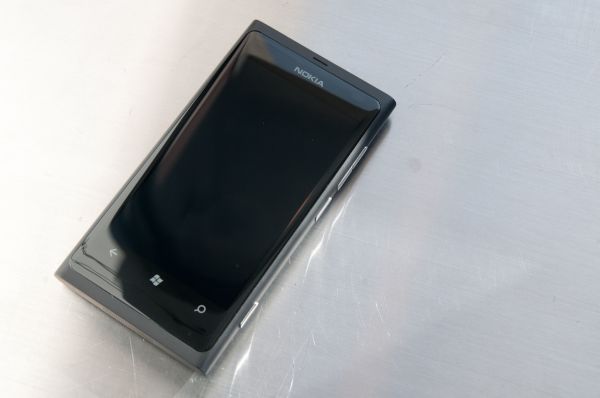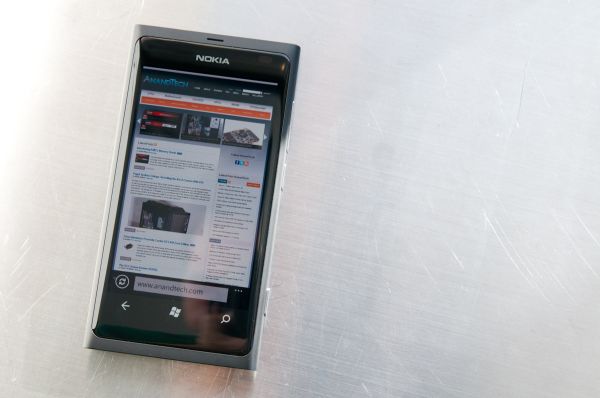Nokia Lumia 800 Review - Nokia's Brave New Foray into WP7
by Brian Klug on January 4, 2012 7:00 AM EST- Posted in
- Smartphones
- Nokia
- windows phone 7
- Mobile
- WP7
- Lumia
- Lumia 800
Conclusions
The Lumia 800 is indubitably the best Windows Phone hardware out there right now. When people previously spoke in hushed tones about wanting Nokia to make Windows Phones, the unspoken reasons for wanting a Nokia WP7 device were a few notable features - a camera without compromises, hardware build quality that’s unique and solid, Nokia’s attention to detail, and Nokia's existing market share and ability to get those devices to market.
The Lumia 800 is unique in that it’s the first step in Nokia’s switch to Windows Phone, and for the large part does fulfill a big cross section of those criteria, at least at the high end. I can’t shake the feeling, however, that many people simply wanted a Nokia N8 running Windows Phone 7 (and its still-unsurpassed camera quality). For whatever reason, however, the platform Nokia chose to go with that would become the Lumia 800 borrowed the N9’s exterior instead.
I have nothing but praise for the physical build quality of the Lumia 800, and it's really that attention to detail which puts the Lumia 800 squarely in the lead, at least in my mind. The competition has similar or identical specifications on paper as well (the same 1.4 GHz MSM8x55 SoC, 8 MP camera, 512 MB of RAM, etc.), so it's in these ancillary features that Windows Phone hardware differentiates itself from the pack.
The Lumia 800 does have a few places where it stumbles, however. The aforementioned charging and battery situation is a notable issue that represents a considerable oversight, and I find myself wishing that, like so many other Nokia devices, the phone shipped with pentaband WCDMA instead of two tri-band variants. Having an internal battery is another point of contention, though it’s hard to judge how good battery life will be after Nokia has patched the power management IC firmware.
There’s also the Windows Phone side of things, where Nokia diehards haven’t pulled any punches taking note of the platform’s shortcomings - lack of USB or external storage, a still fledgling application ecosystem, and a few others. I’m inclined to agree that while the other major smartphone OSes have taken some big steps forwards, WP7.5 only now just arrives at parity with where those OSes were midway through last year. There’s still time for WP7.5 to catch up, but I can’t shake the feeling that despite the OS being so much better than it was when it launched, it still isn’t as powerful as the alternatives. For normal consumers the functionality WP7.5 offers is perfect, but for Symbian and Maemo users looking at the Lumia series it’s a huge deal. On the other hand, Nokia's WP7.5 devices do include Nokia's suite of software, which importantly includes turn by turn GPS navigation (Nokia Drive) for free, where the other WP7 contenders would have you use TeleNav GPS or another subscription service.
While it's unclear in what form or on what carrier the Lumia 800 will arrive stateside, it's clear that something superficially similar to the Lumia 800 is in store for AT&T at least. Among the rest of the Windows Phone contenders, it's arguably neck and neck between the Samsung Focus S and the Lumia 800, but how fast Nokia can fix those charging issues might tip the scales. How the Lumia series does against Windows Phones from Samsung, HTC, and LG remains to be seen, but if the Lumia 800 is any indication of what's in store, I think they're in for some competition.














120 Comments
View All Comments
AnnihilatorX - Wednesday, January 4, 2012 - link
I like how the debug mode battery status readsCharged
65535%
Binary-decimal system for the geeks :)
deputc26 - Wednesday, January 4, 2012 - link
nexusct760ster - Thursday, January 5, 2012 - link
16-bit depth of charge. That's why I strive for True-charge B-)piroroadkill - Wednesday, January 4, 2012 - link
Honestly, the N9 is nicer, being almost the same but with a cleaner front (no windows buttons) and an interesting OS as opposed to WP7.Still, it's a dead end. But a pretty dead end.
Freddo - Wednesday, January 4, 2012 - link
Yep, I'm very interested in the N9 myself. Still haven't bought it yet though, it's been 5+ years since I had a mobile phone without ScummVM and I'm not going back to that now. So someone need to port ScummVM for it first.inplainview - Wednesday, January 4, 2012 - link
I have an N9 and it is a nice device. I use it as a backup to my iPhone and it is quite worth. A bit quirky but still a nice phone. I like it MUCH better than the Android copy devices floating around.sprockkets - Wednesday, January 4, 2012 - link
Only seen one briefly in person. Would have bought it too instead of android were it not for Nokia abandoning the platform.What a way to treat your community Nokia!
bplewis24 - Wednesday, January 4, 2012 - link
Keep telling yourself that. I hope it helps you sleep better at night or something.zwer - Wednesday, January 4, 2012 - link
ScummVM was ported within two months for its predecessor, the N900, and is officially supported by the ScummVM community. Given the virtually identical (considering the ScummVM requirements) architecture from both the software and hardware point of view between Maemo 5 and Maemo 6 / MeeGo Harmattan, I'm quite sure someone will rebuild it for the N9 as well, quite soon.'til then, when it comes to emulators/VMs, the EmuMaster pretty much covers the rest - NES, SNES, GB(A), PSX and Amiga (UAE).
kishorshack - Wednesday, January 4, 2012 - link
I expect Nokia and Intel partnership to continueBut this Nokia CEO stephen elop ruined everything for Nokia
First He went against what consumers wanted & went with WP7 instead of android
He killed Meego and stopped Meego devices
N9 was overly priced and Made available in very few countries
Every single thing was done
Purposely
Sad :(